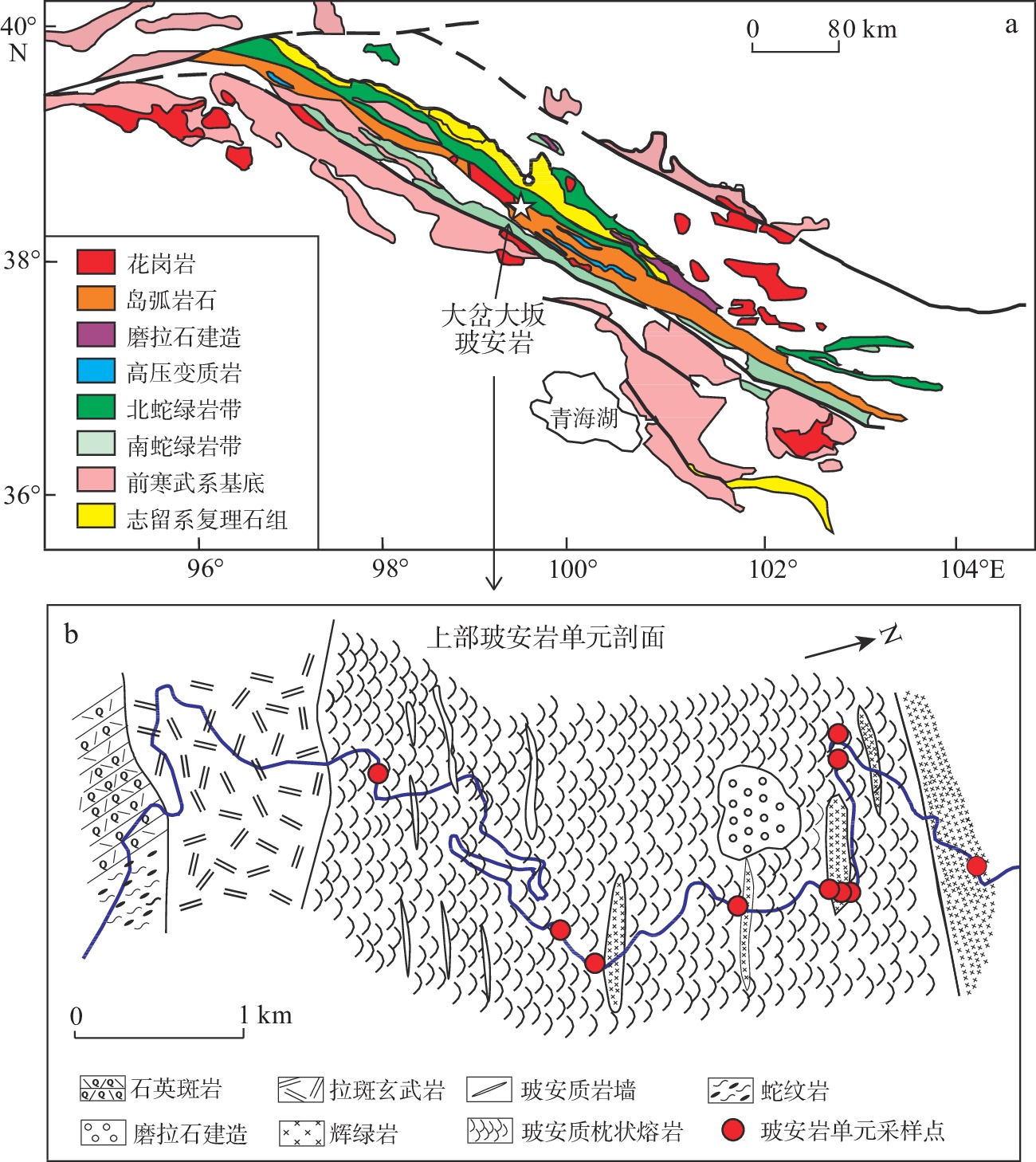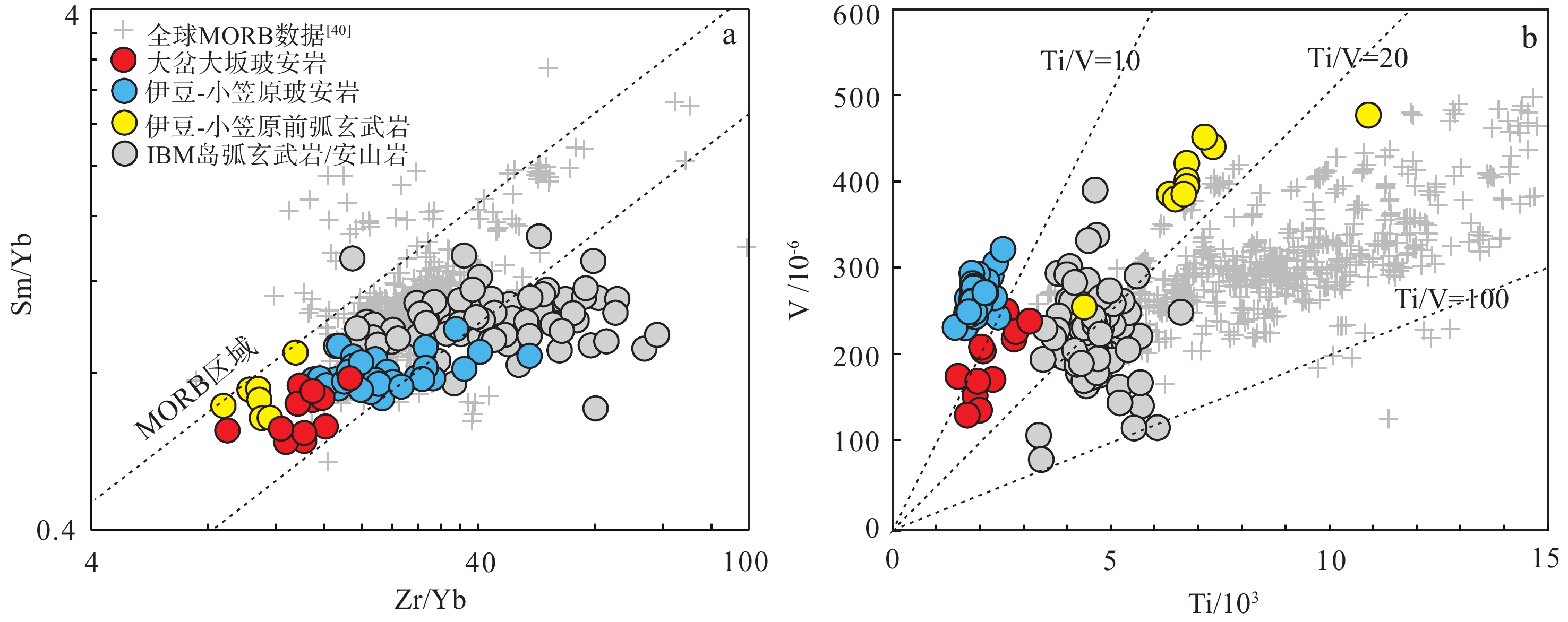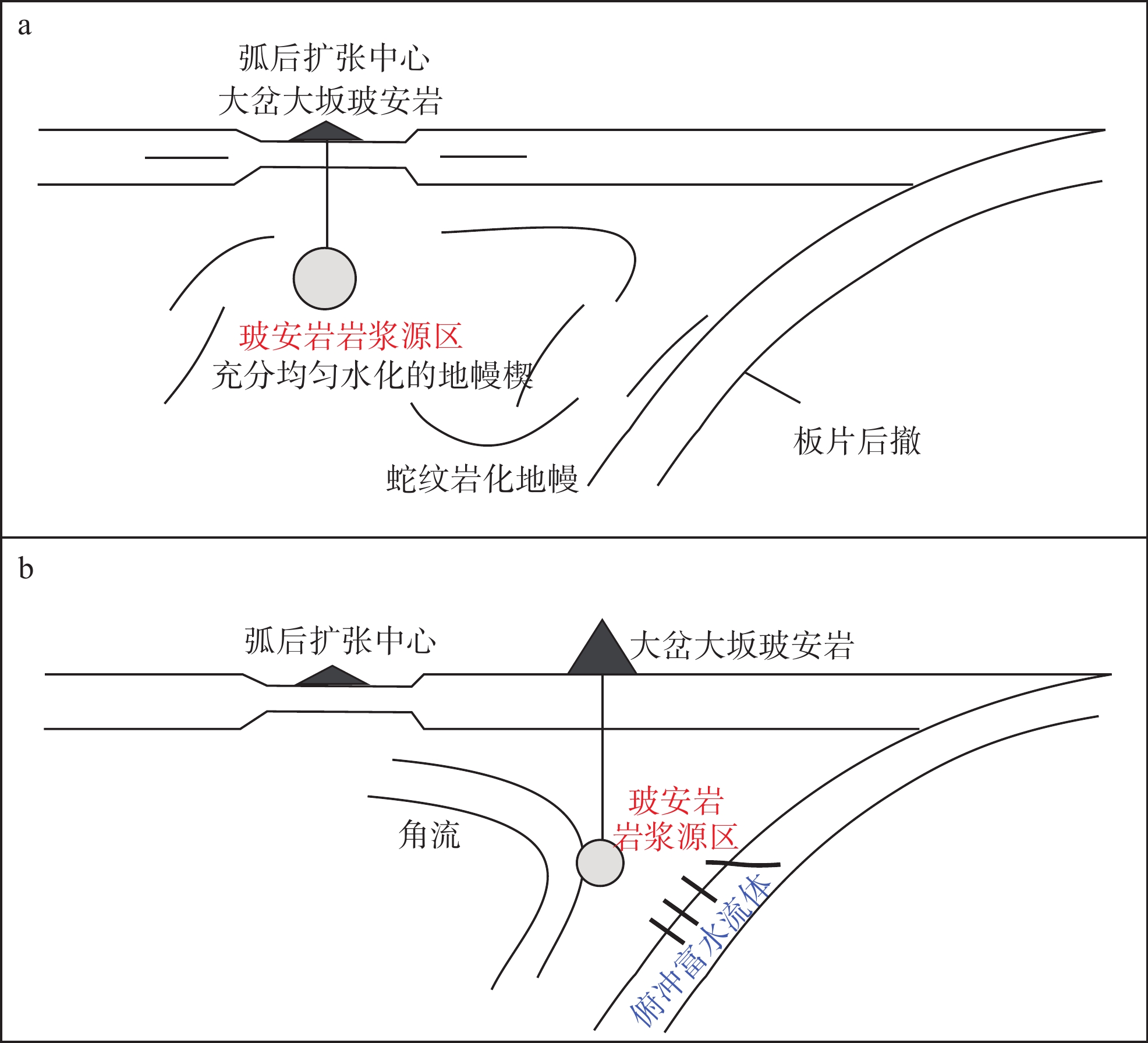Comparison in geochemical characteristics and genesis models of different boninites between Qilian Orogen and Izu-Bonin arc system
-
摘要: 玻安岩为一类具有特殊地球化学性质的岩石,具有高SiO2(>52%)、高MgO(>8%)和低TiO2(<0.5%)等特征。前人认为其形成主要是在俯冲起始阶段大洋板块所释放的流体导致亏损程度较高的难熔地幔楔发生熔融,因此其成因的研究对深入理解板块俯冲起始等地球动力学问题具有重要意义。虽然普遍认为俯冲物质对玻安岩岩浆源区具有重要贡献,但玻安岩中元素的不同富集程度反映了复杂的俯冲板片流体物理化学性质和对玻安岩形成的不同影响。通过对比分析伊豆–小笠原(Izu-Bonin)和北祁连造山带大岔大坂地区玻安岩样品,发现二者具有明显的地球化学差异:与伊豆–小笠原玻安岩相比,大岔大坂玻安岩中没有呈现“U”型稀土配分模式,不富集轻稀土元素或Zr、Hf等元素;而二者流体活动性/不相容元素比值(如Ba/La)变化较大,并具有较高的(87Sr/86Sr)i。这些特征反映了俯冲板片释放的流体和熔体分别对大岔大坂和伊豆–小笠原玻安岩岩浆地幔源区的贡献,从而表明大岔大坂玻安岩形成过程与伊豆–小笠原玻安岩所代表的俯冲初始形成模型不同,更可能形成于存在弧后扩张作用的成熟岛弧阶段。结合区域地质背景和前人研究,本文针对大岔大坂玻安岩成因提出了两种与俯冲初始阶段无关的可能形成机制:① 玻安岩产出于弧后扩张中心,弧后岩石圈的拉张环境和较热的地幔上隆区为玻安质岩浆的形成提供了温压条件,充分交代的水化地幔楔和蛇纹岩化地幔也参与了玻安质岩浆的形成;② 虽与弧后扩张中心相关,但玻安岩的产出位于前弧或弧。由于弧后地幔对弧下深度地幔楔进行侧向加热,导致地幔楔内部对流重新启动,弧后地区已经熔融出弧后玄武岩的残余橄榄岩进入前弧–弧下地幔楔,地幔楔底部和俯冲板片表面被重新加热而发生变质脱水,富水流体交代上部地幔楔使其部分熔融形成玻安质岩浆。Abstract: Boninites are characterized by high-Si (>52 wt.%), high-Mg (>8 wt.%), and low-Ti (<0.5 wt.%). Boninite is thought to be originated from the partial melting of the refractory mantle induced by fluids released from the subducting seafloor during the subduction initiation. Therefore, study on petrogenesis of boninite is of great significance to further understand the geodynamic mechanism of subduction initiation. Although contribution of subducted materials for the boninitic magma source is significant as people commonly believed, the varying enriched extents of incompatible elements among different boninites reflect the complex physicochemical properties of subducting slab-derived fluids for the formation of boninites. In this study, we compared boninite from the Izu-Bonin-Mariana (IBM) arc system and the North Qilian orogenic belt, and found many geochemical differences between them. Compared to Izu-Bonin boninites, boninite from the North Qilian orogeny does not show U-shaped rare earth element (REE) pattern or enriched light REEs and Zr-Hf, while both of them have highly varied ratios of fluid-soluble element to incompatible element (e.g. Ba/La) and high (87Sr/86Sr)i values. These characteristics reflect the contribution of slab-derived fluids / melts to the magma source for Qilian/Izu-Bonin boninite, respectively. Different from the Izu-Bonin boninite, the Qilian boninite is likely to be produced in a mature subduction system with back-arc spreading centers. Combined with previous studies, we proposed two potential ways for the formation of the Qilian boninite unrelated to the seafloor subduction initiation: (1) the back-arc lithosphere extension and the hot mantle upwelling provided a suitable temperature and pressure for the formation of boninite magmas, with the contribution of the hydrated/serpentinized mantle; (2) the corner flow carried the residual peridotite of the back-arc mantle into the sub-arc/fore-arc mantle, which can be melted and possibly induce dehydration of the subducting slab again to produce boninite magmas.
-
Keywords:
- boninites /
- subducting slab /
- fluids /
- geochemistry /
- hydrous melts /
- subduction-zone magmatism
-
玻安岩经常在前弧暴露,且具有高硅、高镁、低钛以及极低的微量元素含量等地球化学特征,其形成常与板块俯冲初始过程的岩浆作用有着重要联系,例如伊豆–小笠原–马里亚纳(Izu-Bonin-Mariana,IBM)、汤加等地[1-6]。玻安岩的地球化学特征反映其形成于地幔楔方辉橄榄岩在相对较浅部位的部分熔融,这种特殊的形成位置要求了较高的热量输入以及必要的俯冲流体加入难熔且亏损的地幔源区[7-8]。典型的玻安岩岩浆活动常分布于大洋汇聚板块边缘,含水玻安岩岩浆与俯冲板片组分进入地幔源区紧密相关。现代岛弧中,玻安岩地层与似洋中脊玄武岩(或称为前弧玄武岩)存在明显的时间先后顺序,即前弧玄武岩在玻安岩之前产出,并与橄榄岩–辉长岩–变质火山岩段同时出现在前弧地区(IBM和Tonga-Kermadec),这些岩石之间的产出时间顺序和成因联系标志着俯冲初始阶段的岩浆作用过程[9-12]。而另一方面,玻安岩也被发现于古大洋板片俯冲体系。Pearce等[13]提出了SSZ(supra-subduction zone)型蛇绿岩代表了俯冲古洋壳的碎片,例如包括Troodos、Oman、祁连在内的蛇绿岩均为与俯冲相关的岩石,记录了大洋岩石圈的残留,并且可能包含了俯冲上盘的洋壳扩张过程(岛弧及弧后盆地的形成)。所以这类玻安岩岩浆可能形成于活动的扩张脊与海沟碰撞所形成的“板片窗”区域[14]。
不同玻安岩的地球化学特征反映了玻安质岩浆不同的形成条件,记录了俯冲板片组分对玻安岩岩浆源区的差异性贡献。前人研究认为,伊豆–小笠原–马里亚纳俯冲体系的玻安岩形成于板块俯冲初始阶段,而大岔大坂玻安岩则形成于板块俯冲初始后的弧后扩张过程之中[3-4,9,15]。因此,本文将对比产出于这两种构造环境的不同类型玻安岩的地球化学特征和成因差异,通过系统的主量、微量元素及Sr同位素组成对比分析,侧重讨论板块俯冲组分对玻安岩岩浆源区不同的物质贡献,从而深入理解这两种玻安岩的成因差异及其地球动力学指示意义。
1. 地质背景
祁连造山带是典型的古大洋俯冲带,保存着较为完好的蛇绿岩序列[16],造山带位于华北板块西南缘的阿拉善地块与中祁连地块之间(图1a),西北部被阿尔金左行走滑断裂切割,北界以走廊过渡带与阿拉善地块相连,南界以托莱山大型右行平移剪切带与中祁连地块毗邻[17]。本文研究的大岔大坂玻安岩单元分布于北祁连造山带中,其向北被石炭纪—二叠纪的沉积岩系与九个泉弧后盆地蛇绿岩带隔开,向南逆冲到北祁连俯冲火山杂岩带上[15],其整体剖面可大致分为上部的蛇绿岩单元和下部的玻安岩单元(图1b),二者之间可能存在断层发育,玻安岩单元以枕状熔岩为主,普遍发育有气孔和杏仁构造,Xia等[18]认为玻安岩单元的形成时代为505~487 Ma。学者对大岔大坂玻安岩的形成环境仍有不同看法,认为可能形成于弧间盆地[19]或岛弧[20]或弧后盆地[21]等地区。伊豆–小笠原弧标志着菲律宾海板块的东部边缘(图2),东以伊豆–小笠原海沟为界,西以四国海盆为界,具有东西向延伸的广阔火山带,是太平洋板块向西俯冲所致[22]。
![]() 图 1 北祁连造山带地质图(a)与大岔大坂玻安岩系剖面图和本文采样点位置(b)[23]Figure 1. Geological map of the North Qilian Orogenic Belt (a), and the cross-section of the Dachadaban boninite series (b)
图 1 北祁连造山带地质图(a)与大岔大坂玻安岩系剖面图和本文采样点位置(b)[23]Figure 1. Geological map of the North Qilian Orogenic Belt (a), and the cross-section of the Dachadaban boninite series (b)2. 样品与分析
2.1 样品选择及岩石学特征
本文的取样点位于下部的玻安岩单元,采集的样品在野外及手标本观察呈灰黑色,致密块状构造,难以观察到斑晶(图3a),多数样品具有典型的枕状构造。在偏光显微镜下可以观察到其为隐晶质、玻璃质结构(图3b),部分样品在镜下可观察到基质的蚀变特征,还有一些出现了定向排列的气孔构造,挑出未明显蚀变的样品进行下一步的地球化学分析。
本文选择的伊豆–小笠原–马里亚纳(IBM)俯冲体系的岩石样品化学组成数据来源于地球化学数据库(PetDB,http://www.earthchem.org/petdb;Georoc,http://georoc.mpch-mainz.gwdg.de/georoc)以及Li等[5]的研究,对应样品分布于小笠原群岛的Mukojima及Chichijima岛。所选数据对应的样品也是保留有未发生蚀变的基质和斑晶,并且没有二次矿物结晶。
2.2 分析方法
2.2.1 主量元素
大岔大坂玻安岩单元样品的主量、微量元素分析均在中国科学院海洋研究所大洋岩石圈与地幔动力学超净实验室完成。称取约50 mg烘干的样品粉末和250 mg的LiBO4于铂金坩埚中,在1050 ℃的马弗炉中加热30分钟后取出,在本生灯上加热样品形成液滴,并倒入50 mL 5%的HNO3溶液中,最后稀释样品溶液至称样重的2000倍。使用Agilent-5100型电感耦合等离子体发射光谱仪(ICP-OES)进行主量元素分析测试,所用的监控标样为美国地质调查局(USGS)的岩石标样AGV-2和BCR-2,分析精度和准确度优于5%,详细分析流程见Chen等[25]。
2.2.2 微量元素
称取大约50 mg样品置于Teflon杯中,加入0.5 mL HNO3 + 1.5mL HF,在烘箱中190 ℃下加热12 h进行初溶。之后将样品蒸干并加入1 mL的HNO3,重复两次进行再次溶解。随后,加入1 mL HNO3 + 4 mL超纯水在190 ℃下加热2 h复溶。最后,用2%的HNO3稀释样品溶液至100 g。样品微量元素测定选用Agilent 7900 型四极杆电感耦合等离子体质谱仪(ICP-MS),并选用美国地质调查局(USGS)岩石样品BCR-2、BHVO-2、W-2A、AGV-2和GSP-2做标样。分析精度优于5%,准确度优于10%,详细分析流程见Chen 等[25]。
2.2.3 Sr同位素
Sr同位素测试前处理工作基本步骤与微量元素测试前处理步骤一致,定容后的溶液采用Sun等的方法对Sr元素进行分离纯化[26],分离纯化后的溶液样品寄送至武汉上谱科技责任有限公司,使用多接收器电感耦合等离子质谱仪(Nu plasma Ⅱ MC-ICP-MS)进行Sr同位素测量。86Sr/88Sr归一化比为0.1194,并采用国际标样NBS-987(Sr)作为标准监测仪器漂移。对国际标样进行重复测试,得出87Sr/86Sr平均值为0.710239±0.000010(n= 5,2σ,NBS-987),在推荐值范围内。随样品一起进行前处理和分析测试的USGS国际标样BCR-2和BHVO-2的Sr同位素也均在推荐范围之内(据GeoReM,http://georem.mpch-mainz.gwdg.de/sample_query_pref.asp)。
3. 结果
3.1 主量元素
由于IUGS火山岩分类方案只适用于阳离子氧化物(即不适用于H2O和CO2),并要求这些氧化物总和为100%,而在氧化条件下熔融样品,会将Fe氧化的质量损失计算为烧失量,因此本文的主量元素数据均运用Pearce[27]的方法进行校正,这一步是为了消除蚀变和脱气作用的影响。后文中分析的数据均为校正后的数据。
通过对祁连大岔大坂地区上部玻安岩单元的23个新鲜枕状熔岩样品进行分析,结果如图4所示,3个样品属于玻安质玄武岩(其MgO和TiO2含量符合国际地科联对玻安岩的定义,然而SiO2含量小于52%,前人将其命名为玻安质玄武岩[28]);12个样品属于上文所述IUGS定义(MgO>8%,TiO2<0.5%,SiO2>52%)的玻安岩[29],均具有较高的MgO含量(8.75%~16.51%),Mg#(0.55~0.71)和较低的TiO2含量(0.27%~0.49%);其余8个样品的MgO含量较玻安岩低(3.65%~7.20%),其中7个样品与玻安岩具有同样低的TiO2含量(0.4%~0.5%)。采集到的样品在TAS图解中均分布于玄武岩–玄武安山岩–安山岩–玄武粗安岩的范围内(图4c),并且所有样品均属于钙碱性玄武岩(图4d),并未发现拉斑玄武岩产出。数据库中选择的伊豆–小笠原样品为符合IUGS定义的玻安岩,并且均属于钙碱性系列岩石,因此不在分类图中具体标出。
3.2 微量元素与Sr同位素
本次研究分析测试的大岔大坂玻安岩样品微量元素组成特征与前人报道相似[18]。CI型碳质球粒陨石标准化稀土元素(REE)蛛网图显示(图5a),大岔大坂玻安岩轻稀土元素(LREE)呈现亏损特征,稀土元素总量较低,∑REE为(3.35~6.31)×10−6,略高于CI型碳质球粒陨石(2.51×10−6)[32]。REE内部分馏程度较弱,(La/Sm)N=0.48~0.87,(Gd/Yb)N=0.82~0.95(CI型碳质球粒陨石标准化)[32-33]。大岔大坂玻安岩还表现出了流体活动性元素(如Ba、Sr、Pb等)较为富集的特征,但Nb、Ta等元素亏损(图5b)。大岔大坂玻安岩(87Sr/86Sr)i变化范围为0.703 645~0.706 494,平均值为0.70542。伊豆–小笠原玻安岩同样显示了流体活动性元素(如Ba、Sr、Pb等)较为富集的特征(图5b蓝色区域)。但与大岔大坂玻安岩不同的是,伊豆–小笠原玻安岩具有“U”型稀土配分模式和LREE富集(图5a),并存在Zr、Hf元素的轻微富集(图5b)。伊豆–小笠原玻安岩(87Sr/86Sr)i 变化范围为0.703275~0.705706,平均值为0.704523。
4. 讨论
4.1 不同玻安岩的地幔源区亏损程度
大岔大坂玻安岩与伊豆–小笠原玻安岩具有较高的MgO含量(>8%),以及较低的Sc、V、Ti元素含量,表明其具有原始岩浆的特点。玻安岩中的Al、Ti以及Zr、Hf、Th、Nb、Ta等元素被认为最不容易受到后期蚀变作用影响,因此这些元素可以用来判断玻安岩的形成原因[36]。大岔大坂玻安岩与伊豆–小笠原玻安岩均具有Nb、Ta、Ti的负异常,这是太古宙及显生宙玻安岩的共同特征,也被认为是与俯冲相关的岩浆作用的关键证据,这种负异常在全球玻安岩中均可发现,很大程度上继承自玻安岩地幔源区[37]。与典型的岛弧玄武岩比较,玻安岩的Yb、Cr等相容性元素含量较低,证明其源区具有更高程度的熔体抽取。大岔大坂玻安岩、伊豆–小笠原玻安岩和伊豆–小笠原前弧玄武岩的Sm/Yb比值均投在MORB阵列的最低端(图6a),而IBM岛弧玄武岩的Sm/Yb比值与MORB相似,且前人研究玻安质岩浆形成深度较浅[7-8, 14],可以排除源区石榴石对Sm/Yb比值的影响。这说明了玻安岩与岛弧玄武岩不同,无法从MORB型地幔源区熔融产生,相对岛弧玄武岩需要更为亏损的地幔源区。Ti和V是地球化学性质相似的过渡元素,主要赋存于辉石中,但V是变价元素,V5+与辉石不相容[7, 11],因此,地幔源区熔体在高氧逸度条件下应具有较低的Ti/V比值。伊豆–小笠原玻安岩的Ti/V比值最低,大岔大坂玻安岩与伊豆–小笠原前弧玄武岩的Ti/V比值较为相似,且高于伊豆–小笠原玻安岩(图6b),说明了大岔大坂玻安岩与伊豆–小笠原前弧玄武岩地幔源区相似的氧逸度和亏损状态[38-39],而伊豆–小笠原玻安岩地幔源区则由于先期的熔体抽取具有更高的亏损程度,并且因为俯冲初始的重新熔融过程具有更高的氧逸度。
4.2 不同俯冲熔/流体对玻安岩岩浆源区的差异性贡献
尽管玻安岩具有相似的亏损地幔源区,但大岔大坂玻安岩具有比伊豆–小笠原玻安岩更低的相容性元素和相应元素比值(例如Zr/Sm比值),可能说明不同俯冲组分对玻安岩岩浆源区产生的不同影响。前人研究表明,玻安岩最为显著的地球化学特征就是 “U”型稀土配分模式[41-42](相对于LREE、HREE而言,MREE较为亏损),而LREE的富集是俯冲熔体组分加入地幔源区的代表性特征[43]。CI型碳质球粒陨石标准化稀土元素蛛网图显示(图5a),伊豆–小笠原玻安岩具有“U”型稀土配分模式特征((La/Sm)N为1.18,(Sm/Yb)N为0.90),存在LREE轻微富集特征,而大岔大坂玻安岩并未存在LREE富集((La/Sm)N为0.70),但HREE富集较为显著((Sm/Yb)N为0.76)。这种不同于伊豆–小笠原玻安岩的稀土配分模式特征,代表了大岔大坂玻安岩可能与前弧产出的玻安岩不同,LREE代表的俯冲熔体组分对其岩浆地幔源区的加入十分有限,也说明了产出位置并非位于受俯冲熔体组分充分交代的前弧地区,而更可能在弧或弧后位置形成,与俯冲初始阶段的岩浆作用无关。
与IBM岛弧系统产出的典型前弧玄武岩、岛弧玄武岩和玻安岩相比,大岔大坂玻安岩的微量元素配分模式显示了与伊豆–小笠原玻安岩及岛弧玄武岩类似的大离子亲石元素和流体活动性元素(Sr、Ba、Pb等)富集的特征(图5b),表明大岔大坂玻安岩岩浆源区受到了大量俯冲富水流体的交代。而其稀土元素配分模式特征与前弧玄武岩最为相似,轻重稀土元素分异不显著,整体上相对平滑,并且二者都亏损高场强元素(HFSE),结合岩石学特点,其主要矿物组成存在伊豆–小笠原玻安岩中没有的斜长石,这说明了大岔大坂玻安岩形成时的冷却速度并不快,斜长石微晶将会率先晶出,这也印证了大岔大坂玻安岩与伊豆–小笠原俯冲初始相关玻安岩不同的形成原因,岩浆形成深度可能更深。
在全球许多玻安岩样品中均存在Zr元素的富集,Zr和Sm在富水溶液中均较难迁移,洋中脊玄武岩(MORB)和苦橄岩代表了难熔程度不同的原始地幔熔融产物,其(Zr/Sm)PM比值近似为1(数据源于PetDB,http://www.earthchem.org/petdb和Plank and Langmuir[44],原始地幔标准化[32]),因此(Zr/Sm)PM>1的玻安岩岩浆地幔源区一定受到了某些高锆含量的组分影响。结合上述Zr和Sm在富水溶液中较难迁移的性质和(Zr/Sm)PM比值与Sm元素含量无相关性的特征,部分玻安岩中的高Zr/Sm比值可以被认为是俯冲板片含水熔体的贡献,而非富水流体的贡献[45]。大岔大坂玻安岩((Zr/Sm)PM为0.83)并不具有与伊豆–小笠原玻安岩类似的高锆特征((Zr/Sm)PM为1.17),而是与前弧玄武岩类似,小于1((Zr/Sm)PM为0.91),说明了大岔大坂玻安岩岩浆源区与仅和软流圈地幔上涌有关的前弧玄武岩类似,受到的含水熔体交代极为有限。
由于Th具有高度不相容的特征,且在俯冲沉积物中含量极为丰富,因此,Th/Yb比值可以反映俯冲组分是否会将沉积物熔体带入玻安岩岩浆地幔源区[2,46-47]。大岔大坂玻安岩(Th/Yb)N比值(N-MORB标准化[33])约为3.79,低于岛弧岩浆岩(5.23)及伊豆–小笠原玻安岩(4.46),而高于伊豆–小笠原前弧玄武岩(1.33),说明了大岔大坂玻安岩岩浆源区中受到的俯冲沉积物熔体的影响也较为有限,印证了(Zr/Sm)PM比值和稀土元素组成共同指示的源区缺少含水熔体的特征。(Sr/Nd)N与(Th/Yb)N关系(图7a)显示了大岔大坂玻安岩的(Th/Yb)N几乎不变,仅比MORB值稍高,但(Sr/Nd)N比值存在明显升高趋势,相比而言,伊豆–小笠原玻安岩的两种元素比值为正相关关系,随(Sr/Nd)N的快速增加,(Th/Yb)N缓慢增加,而IBM岛弧火山岩的两种元素比值之间具有明显的负相关关系。这说明加入大岔大坂玻安岩岩浆源区的俯冲组分并不像加入伊豆–小笠原玻安岩源区的俯冲熔/流体一样均处于较高水平,也并非像IBM岛弧下源区俯冲熔/流体一样为此消彼长的动态平衡状态,而是加入其岩浆源区的含水熔体极少,富水流体很多。说明前弧大量俯冲含水熔体难以对大岔大坂玻安岩源区产生影响,岩浆源区离海沟更远,而伊豆–小笠原玻安岩岩浆地幔源区先期就受到了广泛熔/流体的交代作用。
已知俯冲板片组分(沉积物/蚀变洋壳)产生的富水流体可以选择性地携带流体可迁移元素(如Ba-Rb-Cs-Pb-Sr),且利用海水的Sr同位素组成估计其具有较高的87Sr/86Sr(0.07075~0.7090)[48-50]。大岔大坂玻安岩的LILE/LREE比值(如Ba/La)变化幅度很大,且平均(87Sr/86Sr)i高于岛弧玄武岩(图7b),反映了俯冲板片脱水产生的富水流体对大岔大坂玻安岩岩浆的贡献占主导地位。上述元素及同位素特征共同揭示了大岔大坂玻安岩岩浆源区可能不同于伊豆–小笠原玻安岩岩浆源区所代表的俯冲初始阶段高温下熔/流体交代的地幔橄榄岩,而应仅为俯冲富水流体交代而成的水化地幔橄榄岩,且源区位置不在距离海沟较近的前弧之下,而位于较深的弧下地幔。
4.3 大岔大坂玻安岩与俯冲初始无关的形成模型
大岔大坂玻安岩的元素比值特征和微量元素配分模式与伊豆–小笠原等地的玻安岩相比均有较大区别,其并未强烈富集LREE,没有显示明显的“U”型稀土配分模式特征和Th、Zr、Hf等元素的富集,这说明了大岔大坂玻安岩岩浆源区未经受俯冲大洋沉积物以及俯冲板片熔体的交代,这也意味着该地玻安岩与伊豆–小笠原玻安岩产出的构造环境和所反映的岩浆作用有着较大区别。具体而言,祁连大岔大坂玻安岩与伊豆–小笠原前弧地区发现的玻安岩不同,并非在俯冲初始阶段形成,而是形成于俯冲带演化较为成熟时。因此我们提出形成大岔大坂玻安岩两种可能的与俯冲初始无关的模型(图8):
(1)高角度俯冲背景下,由于摩擦诱发的上地幔对流将大部分被反折而形成向上的环流,并由此造成岩石圈的拉张环境和较热的地幔上隆区,导致了玻安岩岩浆形成的低压高温条件。并且成熟俯冲带地幔楔经历了较为充分的俯冲组分交代作用(主要为富水流体的交代)和先期前弧玄武岩部分熔融导致地幔的较高难熔程度,这种地幔橄榄岩部分熔融最终形成了玻安质岩浆(图8a)。该模型尚未解决的问题是,弧后地区在没有足够多俯冲流体加入的条件下,是否能产生适合水化地幔橄榄岩熔融的温度和压力条件。前人研究表明,13%的弧前地幔会在20~60 km的深度被蛇纹岩化[52]。这些浅部蛇纹岩化地幔可通过拖曳–俯冲或俯冲侵蚀作用进入地幔深部, 参与弧后位置幔源岩浆的形成。Zheng[53]的研究表明,俯冲板片的后撤可以诱发软流圈的侧向流动,进而导致地幔楔底部和板片的解耦以及温度升高,可以诱发弧后深度的板片释放熔/流体交代上地幔进而形成玄武岩,这些研究均可说明弧后地区有可以产生玻安岩岩浆作用的客观条件,这种情况下会先在更靠近海沟的地区形成岛弧玄武岩,之后随着弧后扩张中心的形成而产生玻安质岩浆作用,最后会产生弧后玄武岩,若地层序列较为完整未受破坏,会形成下部岛弧玄武岩、中部玻安岩,上部弧后玄武岩的完整层序。
(2)玻安岩可能并不是在弧后扩张中心形成,而是由于俯冲的继续进行,弧后地幔对弧下地幔楔进行侧向加热,导致地幔楔内部对流重新启动,并把热量带到地幔楔底部乃至俯冲板片顶部。因此,地幔楔底部和俯冲板片表面会被重新加热而发生变质脱水,富水流体交代上部地幔楔使其部分熔融形成玻安质岩浆,这种情况下难以在玻安岩产出位置附近找到弧后玄武岩,并且其下伏岩石单元应为前弧或岛弧玄武岩(图8b)。
5. 结论
(1)祁连造山带大岔大坂玻安岩强烈富集大离子亲石元素,但并未呈现伊豆–小笠原玻安岩具有的“U”型稀土配分模式、轻稀土元素富集以及Zr、Hf元素轻微富集的特征,表明大岔大坂玻安岩较为亏损的地幔源区没有俯冲含水熔体组分的加入,而是存在大量俯冲富水流体组分的交代,可能形成于存在弧后扩张作用的岛弧成熟阶段而非俯冲初始阶段。
(2)结合亏损的地幔源区和俯冲富水流体组分加入的特征,提出祁连造山带大岔大坂地区玻安岩的形成可能与伊豆–小笠原玻安岩指示的俯冲初始无关:第一种情况,弧后岩石圈的拉张环境和较热的地幔上隆区为玻安岩的形成提供了温压条件,充分交代的水化地幔楔和蛇纹岩化地幔也参与了玻安质岩浆的形成;第二种情况虽也与弧后扩张中心相关,但玻安岩的产出位于前弧或弧。弧后地幔对弧下深度地幔楔进行侧向加热,导致地幔楔内部对流重新启动,角流将弧后地区的残余橄榄岩带入到了前弧–弧下地幔楔,且把热量带到地幔楔底部乃至俯冲板片顶部,因此,地幔楔底部和俯冲板片表面会被重新加热而发生变质脱水,最终导致弧下亏损的地幔橄榄岩部分熔融形成玻安岩。
致谢:中国科学院海洋研究所王晓红、段梦、龚红梅协助进行了地球化学测试,在此一并感谢。
-
图 1 北祁连造山带地质图(a)与大岔大坂玻安岩系剖面图和本文采样点位置(b)[23]
Figure 1. Geological map of the North Qilian Orogenic Belt (a), and the cross-section of the Dachadaban boninite series (b)
图 2 伊豆–小笠原–马里亚纳弧系统地质图(a)和小笠原弧具体细节及本文在数据库中所获得的数据点对应样品位置(b)
修改自Geochem网站,点位来源于Li等[5]以及Ishizuka等[24]。
Figure 2. Geological map of the Izu-Bonin-Mariana arc system (a) and details of the Bonin arc segment and sample point obtained in the database (b)
Modified from Geochem, sample point from Li et al[5] and Ishizuka et al[24].
-
[1] Parkinson I J, Hawkesworth C J, Cohen A S. Ancient mantle in a modern arc: Osmium isotopes in Izu-Bonin-Mariana forearc peridotites [J]. Science, 1998, 281(5385): 2011-2013. doi: 10.1126/science.281.5385.2011
[2] Stern R J. Subduction zones [J]. Reviews of Geophysics, 2002, 40(4): 1012.
[3] Reagan M K, Ishizuka O, Stern R J, et al. Fore-arc basalts and subduction initiation in the Izu-Bonin-Mariana system [J]. Geochemistry, Geophysics, Geosystems, 2010, 11(3): Q03X12.
[4] Ishizuka O, Hickey-Vargas R, Arculus R J, et al. Age of Izu-Bonin-Mariana arc basement [J]. Earth and Planetary Science Letters, 2018, 481: 80-90. doi: 10.1016/j.jpgl.2017.10.023
[5] Li H Y, Zhao R P, Li J, et al. Molybdenum isotopes unmask slab dehydration and melting beneath the Mariana arc [J]. Nature Communications, 2021, 12(1): 6015. doi: 10.1038/s41467-021-26322-8
[6] Shervais J W, Reagan M K, Godard M, et al. Magmatic response to subduction initiation, Part II: boninites and related rocks of the Izu-Bonin arc from IODP expedition 352 [J]. Geochemistry, Geophysics, Geosystems, 2021, 22(1): e2020GC009093.
[7] Crawford A J, Falloon T J, Green D H. Classification, petrogenesis and tectonic setting of boninites[M]//Crawford A J. Boninites and Related Rocks, Unwin and Hyman. London: Australian Research Council, 1989: 1-49.
[8] Falloon T J, Danyushevsky L V. Melting of refractory mantle at 1 · 5, 2 and 2 · 5 GPa under, anhydrous and H2O-undersaturated conditions: Implications for the petrogenesis of high-Ca boninites and the influence of subduction components on mantle melting [J]. Journal of Petrology, 2000, 41(2): 257-283. doi: 10.1093/petrology/41.2.257
[9] Ishizuka O, Kimura J, Li Y, et al. Early stages in the evolution of Izu–Bonin arc volcanism: New age, chemical, and isotopic constraints [J]. Earth and Planetary Science Letters, 2006, 250(1-2): 385-401. doi: 10.1016/j.jpgl.2006.08.007
[10] Dilek Y, Thy P. Island arc tholeiite to boninitic melt evolution of the Cretaceous Kizildag (Turkey) ophiolite: model for multi-stage early arc-forearc magmatism in Tethyan subduction factories [J]. Lithos, 2009, 113(1-2): 68-87. doi: 10.1016/j.lithos.2009.05.044
[11] Reagan M K, Pearce J A, Petronotis K, et al. Subduction initiation and ophiolite crust: new insights from IODP drilling [J]. International Geology Review, 2017, 59(11): 1439-1450. doi: 10.1080/00206814.2016.1276482
[12] Stern R J. Subduction initiation: spontaneous and induced [J]. Earth and Planetary Science Letters, 2004, 226(3-4): 275-292. doi: 10.1016/S0012-821X(04)00498-4
[13] Pearce J A. Role of the sub-continental lithosphere in magma genesis at active continental margins[M]//Hawkesworth C J, Norry M J. Continental Basalts and Mantle Xenoliths. Nantwich, Cheshire: Shiva Publications, 1983: 230-249.
[14] König S, Münker C, Schuth S, et al. Boninites as windows into trace element mobility in subduction zones [J]. Geochimica et Cosmochimica Acta, 2010, 74(2): 684-704. doi: 10.1016/j.gca.2009.10.011
[15] 宋述光, 吴珍珠, 杨立明, 等. 祁连山蛇绿岩带和原特提斯洋演化[J]. 岩石学报, 2019, 35(10):2948-2970 doi: 10.18654/1000-0569/2019.10.02 SONG Shuguang, WU Zhenzhu, YANG Liming, et al. Ophiolite belts and evolution of the proto-tethys ocean in the qilian orogen [J]. Acta Petrologica Sinica, 2019, 35(10): 2948-2970. doi: 10.18654/1000-0569/2019.10.02
[16] 赵国军. 中祁连西段早古生代洋内弧后盆地岩浆作用的厘定及地质意义的研究[D]. 西北大学硕士学位论文, 2019. ZHAO Guojun. Determination and geological significance of magmatism in the Early Paleozoic intra-ocean back-arc basins in The Western Central Qilian belt[D]. Master Dissertation of Northwest University, 2019.
[17] 孟繁聪, 张建新, 郭春满, 等. 大岔大坂MOR型和SSZ型蛇绿岩对北祁连洋演化的制约[J]. 岩石矿物学杂志, 2010, 29(5):453-466 doi: 10.3969/j.issn.1000-6524.2010.05.001 MENG Fancong, ZHANG Jianxin, KER C M, et al. Constraints on the evolution of the North Qilian ocean basin: MOR-type and SSZ-type ophiolites from Dachadaban [J]. Acta Petrologica et Mineralogica, 2010, 29(5): 453-466. doi: 10.3969/j.issn.1000-6524.2010.05.001
[18] Xia X H, Song S G, Niu Y L. Tholeiite–Boninite terrane in the North Qilian suture zone: Implications for subduction initiation and back-arc basin development [J]. Chemical Geology, 2012, 328: 259-277. doi: 10.1016/j.chemgeo.2011.12.001
[19] 冯益民, 何世平. 北祁连蛇绿岩的地质地球化学研究[J]. 岩石学报, 1995, 11(S1):125-146 FENG Yimin, HE Shiping. Research for geology and geochemistry of several ophiolites in the north Qilian Mountains, China [J]. Acta Petrologica Sinica, 1995, 11(S1): 125-146.
[20] 张旗, 钱青, 陈雨. 蛇绿岩、蛇绿岩上覆岩系及其与洋壳的对比[J]. 地学前缘, 1998, 5(4):193-200 doi: 10.3321/j.issn:1005-2321.1998.04.002 ZHANG Qi, QIAN Qing, CHEN Yu. Ophiolite, overlying rock series of ophiolite and their comparison to the oceanic crust [J]. Earth Science Frontiers, 1998, 5(4): 193-200. doi: 10.3321/j.issn:1005-2321.1998.04.002
[21] 韩松, 贾秀琴, 钱青, 等. 北祁连大岔大坂两类辉长岩的地质地球化学特征及其构造环境[J]. 岩石矿物学杂志., 2000, 19(2):106-112 HAN Song, JIA Xiuqin, QIAN Qing, et al. Geological and geochemical characteristics of two types of gabbro in Dachadaban, North Qilian and its tectonic environment [J]. Acta Petrologica et Mineralogica, 2000, 19(2): 106-112.
[22] Li H, Arculus R J, Ishizuka O, et al. Basalt derived from highly refractory mantle sources during early Izu-Bonin-Mariana arc development [J]. Nature Communications, 2021, 12(1): 1723. doi: 10.1038/s41467-021-21980-0
[23] Song S G, Niu Y L, Su L, et al. Tectonics of the North Qilian orogen, NW China [J]. Gondwana Research, 2013, 23(4): 1378-1401. doi: 10.1016/j.gr.2012.02.004
[24] Ishizuka O, Taylor R N, Umino S, et al. Geochemical evolution of arc and slab following subduction initiation: a record from the Bonin Islands, Japan [J]. Journal of Petrology, 2020, 61(5): egaa050. doi: 10.1093/petrology/egaa050
[25] Chen S, Wang X H, Niu Y L, et al. Simple and cost-effective methods for precise analysis of trace element abundances in geological materials with ICP-MS [J]. Science Bulletin, 2017, 62(4): 277-289. doi: 10.1016/j.scib.2017.01.004
[26] Sun P, Niu Y L, Guo P Y, et al. Elemental and Sr-Nd-Pb isotope geochemistry of the Cenozoic basalts in Southeast China: Insights into their mantle sources and melting processes [J]. Lithos, 2017, 272-273: 16-30. doi: 10.1016/j.lithos.2016.12.005
[27] Pearce J A, Reagan M K. Identification, classification, and interpretation of boninites from Anthropocene to Eoarchean using Si-Mg-Ti systematics [J]. Geosphere, 2019, 15(4): 1008-1037. doi: 10.1130/GES01661.1
[28] Perez A, Umino S, Yumul G P Jr, et al. Boninite and boninite-series volcanics in northern Zambales ophiolite: doubly vergent subduction initiation along Philippine Sea plate margins [J]. Solid Earth, 2018, 9(3): 713-733. doi: 10.5194/se-9-713-2018
[29] Le Bas M J. IUGS reclassification of the High-Mg and picritic volcanic rocks [J]. Journal of Petrology, 2000, 41(10): 1467-1470. doi: 10.1093/petrology/41.10.1467
[30] Ohnenstetter D, Brown W L. Compositional variation and primary water contents of differentiated interstitial and included glasses in boninites [J]. Contributions to Mineralogy and Petrology, 1996, 123(2): 117-137. doi: 10.1007/s004100050146
[31] Miyashiro A. Volcanic rock series in island arcs and active continental margins [J]. American Journal of Science, 1974, 274(4): 321-355. doi: 10.2475/ajs.274.4.321
[32] Mcdonough W F, Sun S S. The composition of the earth [J]. Chemical Geology, 1995, 120(3-4): 223-253. doi: 10.1016/0009-2541(94)00140-4
[33] Sun S S, McDonough W F. Chemical and isotopic systematics of oceanic basalts: implications for mantle composition and processes [J]. Geological Society, London, Special Publications, 1989, 42(1): 313-345. doi: 10.1144/GSL.SP.1989.042.01.19
[34] Taylor B, Fujioka K. Rifting and the volcanic-tectonic evolution of the Izu-Bonin-Mariana arc[C]. Proceedings of the Ocean Drilling Program, Scientific Results, 1992, 126: 627-651.
[35] Kanayama K, Umino S, Ishizuka O. Eocene volcanism during the incipient stage of Izu-Ogasawara Arc: geology and petrology of the Mukojima Island Group, the Ogasawara islands [J]. Island Arc, 2012, 21(4): 288-316. doi: 10.1111/iar.12000
[36] Patriat M, Falloon T, Danyushevsky L, et al. Subduction initiation terranes exposed at the front of a 2 Ma volcanically-active subduction zone [J]. Earth And Planetary Science Letters, 2019, 508: 30-40. doi: 10.1016/j.jpgl.2018.12.011
[37] Singh M R, Manikyamba C, Ganguly S, et al. Paleoproterozoic arc basalt-boninite-high magnesian andesite-Nb enriched basalt association from the Malangtoli volcanic suite, Singhbhum Craton, eastern India: Geochemical record for subduction initiation to arc maturation continuum [J]. Journal of Asian Earth Sciences, 2017, 134: 191-206. doi: 10.1016/j.jseaes.2016.09.015
[38] Whattam S A, Stern R J. Late Cretaceous plume-induced subduction initiation along the southern margin of the Caribbean and NW South America: The first documented example with implications for the onset of plate tectonics [J]. Gondwana Research, 2015, 27(1): 38-63. doi: 10.1016/j.gr.2014.07.011
[39] Umino S, Kanayama K, Kitamura K, et al. Did boninite originate from the heterogeneous mantle with recycled ancient slab? [J]. Island Arc, 2018, 27(1): e12221. doi: 10.1111/iar.12221
[40] Jenner F E, O'neill H S C. Analysis of 60 elements in 616 ocean floor basaltic glasses [J]. Geochemistry, Geophysics, Geosystems, 2012, 13(2): Q02005.
[41] Murton B J. Tectonic controls on boninite genesis [J]. Geological Society, London, Special Publications, 1989, 42(1): 347-377. doi: 10.1144/GSL.SP.1989.042.01.20
[42] Meffre S, Falloon T J, Crawford T J, et al. Basalts erupted along the Tongan fore arc during subduction initiation: Evidence from geochronology of dredged rocks from the Tonga fore arc and trench [J]. Geochemistry, Geophysics, Geosystems, 2012, 13(12): Q12003.
[43] 熊小林, 刘星成, 李立, 等. 俯冲带微量元素分配行为研究: 进展和展望[J]. 中国科学:地球科学, 2020, 63(12):1938-1951 doi: 10.1007/s11430-019-9631-6 XIONG Xiaolin, LIU Xingcheng, LI Li, et al. The partitioning behavior of trace elements in subduction zones: Advances and prospects [J]. Science China Earth Sciences, 2020, 63(12): 1938-1951. doi: 10.1007/s11430-019-9631-6
[44] Plank T, Langmuir C H. The chemical composition of subducting sediment and its consequences for the crust and mantle [J]. Chemical Geology, 1998, 145(3-4): 325-394. doi: 10.1016/S0009-2541(97)00150-2
[45] Manikyamba C, Naqvi S M, Subba Rao D V, et al. Boninites from the Neoarchaean gadwal greenstone belt, Eastern Dharwar Craton, India: implications for Archaean subduction processes [J]. Earth and Planetary Science Letters, 2005, 230(1-2): 65-83. doi: 10.1016/j.jpgl.2004.06.023
[46] Falloon T J, Crawford A J. The petrogenesis of high-calcium boninite lavas dredged from the northern Tonga Ridge [J]. Earth and Planetary Science Letters, 1991, 102(3-4): 375-394. doi: 10.1016/0012-821X(91)90030-L
[47] Plank T. Constraints from thorium/lanthanum on sediment recycling at subduction zones and the evolution of the continents [J]. Journal of Petrology, 2005, 46(5): 921-944. doi: 10.1093/petrology/egi005
[48] Veizer J. Strontium isotopes in seawater through time [J]. Annual Review of Earth and Planetary Sciences, 1989, 17: 141-167. doi: 10.1146/annurev.ea.17.050189.001041
[49] Elliott T, Plank T, Zindler A, et al. Element transport from slab to volcanic front at the Mariana arc [J]. Journal of Geophysical Research: Solid Earth, 1997, 102(B7): 14991-15019. doi: 10.1029/97JB00788
[50] Van Der Straaten F, Halama R, John T, et al. Tracing the effects of high-pressure metasomatic fluids and seawater alteration in blueschist-facies overprinted eclogites: Implications for subduction channel processes [J]. Chemical Geology, 2012, 292-293: 69-87. doi: 10.1016/j.chemgeo.2011.11.008
[51] Plank T. The chemical composition of subducting sediments[M]//Keeling P F. Treatise on Geochemistry. 2nd ed. Amsterdam: Elsevier, 2014: 607-629.
[52] Savov I P, Ryan J G, D'Antonio M, et al. Shallow slab fluid release across and along the Mariana arc-basin system: Insights from geochemistry of serpentinized peridotites from the Mariana fore arc [J]. Journal of Geophysical Research:Solid Earth, 2007, 112(B9): B09205.
[53] Zheng Y F. Subduction zone geochemistry [J]. Geoscience Frontiers, 2019, 10(4): 1223-1254. doi: 10.1016/j.gsf.2019.02.003




 下载:
下载:







